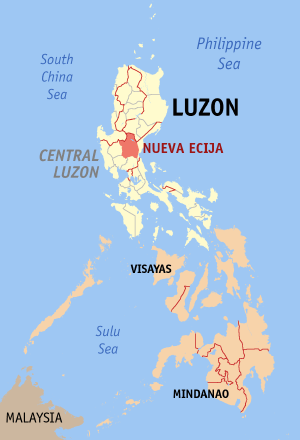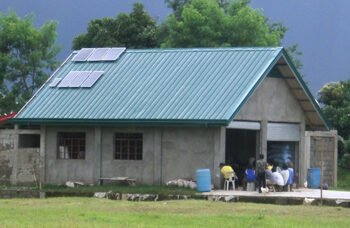ABM Archive Website
THIS WEBSITE CONTAINS ARCHIVE MATERIALS FOR HISTORICAL REFERENCE ONLY
For up-to-date information, including our latest appeals, news, and resources, please visit our current website.
Update: Philippines Economic Empowerment
 Learnings and Best Practices from Santa Maria
Learnings and Best Practices from Santa Maria
Santa Maria is a barangay (village or district) of the Municipality of Licab in the Province of Nueva Ecija. Aside from Ilocanos and Tagalogs who are natives of the place, it is also home to migrants from the Cordilleras who used to work in the mines of Acoje and Masinloc in Zambales which have later closed and who have used their separation pay to buy small landholdings in the area. Some of the migrants came directly from Mountain Province or Benguet in search of greener pastures. It is also home to the congregation of Annunciation Church in the Episcopal Diocese of Central Philippines.
At that time, the ECP’s development program was undergoing a major shift to the Asset-Based Community Development approach and its Executive Council has adopted the “Receivers-to-Givers” Policy which directed communities receiving development grants to be transformed into givers by sharing the blessings of their projects to other communities or groups. Partner communities would have to pay back the amount that they received from the program so this can be given to another group or community to support similar development ventures. In this way, dependence is eliminated and a system of sharing is put in place. But since it was an almost complete reversal of its erstwhile grants-based support that it practiced for more than 20 years, the program agreed that repayment periods can be long term even as long as 5 years.Some years ago, this community was the recipient of an integrated development project, consisting of a water system, solar dryer, warehouse and charging station that cost more than a million pesos in grant assistance. While the ECP’s development program was intended to improve economic conditions and build up the self-reliance capacity of communities, projects sometimes had the opposite effect of inaugurating a relationship of dependence on the Church. When the integrated project was completed and turned over to Santa Maria through the Annunciation Credit Cooperative which was the organizational entity established to manage the project, it was with the understanding that the latter would assume responsibility for such management and maintenance. But a few months after the turn over, the water system broke down and the people came back to the Church requesting that it repairs the same. When a strong typhoon blew the roof of the warehouse another request was made for the Church to rehabilitate it. Soon, solicitation letters were received from the community almost every time a calamity hit the area.
The next time Santa Maria, through Annunciation Church and the Annunciation Credit Cooperative asked for farm assistance from the program, the ABCD approach and the “Receivers-to-Givers” Policy were explained to them and were bluntly informed that the Church no longer just gave grants. Surprisingly in a very pleasant manner, they embraced the approach and policy and expressed agreement that it will actually result in a better relationship. Furthermore, they stated that the assistance they are applying for, in the amount of P500,000 to be used for the purchase of seeds and farm inputs, would be paid not in five 5 years but in 6 months or at harvest time. They were also willing to pay interest at the rate of 1.5% per month, to be allocated, as follows: a) 0.5% for the Cooperative; b) 0.5% for Annunciation Church; and, c) 0.5% to the development program, which they said was substantially lower than the usual rate of 3.5% per month and even beyond that they were then currently availing from private lenders.
The first farm assistance was made in November 2012. By the first week of July 2013, the Cooperative fully paid P500,000, plus P12,000 as add-on to principal while also realizing income of P40,782 for itself and a similar amount given to Annunciation Church. The add-on of P12,000 return on principal was utilized to rehabilitate the water system. A month after the payment of the first loan, they requested for P200,000 which they fully paid in October 2013. The next month, they took out P1.2 million that was similarly fully paid in May 2014, with the Cooperative earning P36,000 and giving the same amounts to the local church and to the development program. Towards the latter part of June 2014, they took out another loan of P900,000.
In the Cooperative’s report on the use of the recently-paid loan of P1.2 million, 3 persons have acquired 3 hectares of land, which is the first formally recorded land acquisition in the ECP’s development program. This is very significant in light of the program’s renewed and intentional effort to enable communities to gain access to the country’s capital resources that would assure them of long term sustainability.
 |
| The roof of this warehouse, on which is installed the solar panels for the power charging station, was completely blown off by a typhoon. The community kept appealing to the development program to rehabilitate the building. It is now being restored by the community through a non-interest bearing loan under the ECP’s “Receivers-to-Givers” Policy. |
In October 2013, Typhoon Santi (Nari) hit Nueva Ecija and damaged many houses in Santa Maria. But instead of doing the usual circulation of appeal letters, those affected, through the Cooperative, applied for a non-interest loan of P115,000, payable in 2 years, to rebuild their houses. The development program readily approved the application, noting the major shift in paradigm. Moreover, when super-typhoon Yolanda (Haiyan) hit Central Philippines, the Cooperative declared that it was shortening the original 2-year repayment period to only 1 year to make the fund available for work in the Yolanda-affected communities.
Also, the Cooperative, in April 2014, secured another loan so that it can repair the warehouse for which a grant request was rejected by the program 2 years ago.
Since November 2012, the engagement with Santa Maria has brought several learnings that validate the correctness of the ABCD approach and the “Receivers-to-Givers” Policy and which are now considered Best Practices, as follows:
1) Under the previous grants-based support system, the development engagement or partnership is concluded when the project is completed and turned over to the community. Since the projects usually involved grants of substantial amounts, the program simply cannot continually provide subsequent grants. If the community does not put in place systems and processes to ensure the long-term sustainability of the project, a major damage to the same caused by disasters would almost certainly result in its complete failure, such as what happened in Santa Maria as discussed above. But even if the project continues, such as the water systems established by the program in many communities most of which continue to be functional even after more than 10 to 20 years, the community engagement just ends up with such water project and other more significant community visions are not addressed. It is a common situation for a community to gain a better access to potable water and yet no significant dent on its economic marginalization is positively made.
With the new system of engagement, the partner community can continue to receive livelihood support funds for as long as it gives back. The small landowners of Santa Maria can continue to receive loans to purchase more lands and equipment or build up their fixed deposits at the Cooperative for as long as they pay back. The continuous process of receiving and giving back, even it takes forever, is a healthy engagement because of its inherent character of sharing blessings with others and with the local church and the program.
During a visit to Naungan in Ormoc City where the disaster response program has loaned out P480,000 to the Yolanda-affected community, it was explained that this amount could actually be given as grant to those who availed of it. Participating households have availed of P5,000 to P15,000 assistance which has enabled them, mostly fisherfolks, to repair their fish cages or rebuild their livelihoods. But if it is considered as grant, then it is the end of the engagement and E-CARE will move on to the next community. The grant would have restored economic activities in Naungan and people may have re-gained pre-Yolanda livelihoods. But this is not the only possibility when they take the amounts as loans. Because after they have paid, they can ask for bigger amounts not just to repair a fish cage but to build a new one or to establish another livelihood. The possibilities are just endless and a lifeline to such possibilities has just been opened. It is therefore not surprising that, following the explanations, the community embraced the “receivers-to-givers” policy and discarded the grant arrangement.
2) The Santa Maria experience has demonstrated the greater benefits of a shorter repayment period and the consequent junking of long-term arrangements. Firstly, it allows the recipients to take out subsequent loans of varied amounts depending on actual needs. Imagine if the initial loan of P500,000 was payable in five (5) years, it wouldn’t have made much difference because it was for the purchase of seeds and farm inputs for one particular agricultural cycle only. By the time it was due, people may already have forgotten about it. With the short-term period, however, the community has already availed of P2.8 million in less than two (2) years, which allowed for, among others, the purchase of 3 hectares of land, equipments, etc. Secondly, as the Cooperative has said, the loan is held and interest paid for it when it is being actually utilized. During the months when it is not in such utilization, the recipient wouldn’t have to pay for interests. Thirdly, the engagement between the recipient and the program is continuous and success stories are constantly shared and learned.
3) In a loan program, there will always be delinquencies. Annunciation Credit Cooperative has shown the way to address this by assuming responsibility for the payment of its delinquent members. In other words, this Cooperative has built up the capacity to be able to do this so that, as the main partner in the relationship with the Church, it does not default in any of its obligations. At its first loan of P500,000, there were a number of delinquents from among its members but in order to be able to take out a subsequent loan, it covered the payments of the delinquents who later realized that they will be losing a “lifeline” to very low interests if they did not settle. It is now required for other community partners that they must also build up a similar capacity for their respective associations. This may entail starting with smaller and manageable amounts while building up the reserves of the managing association or cooperative.


